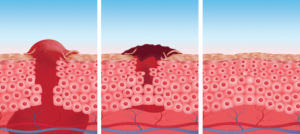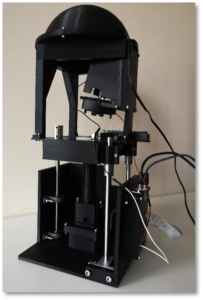
Authored by Ana Maria Rubio Denniss, Research Associate, University of Bristol
Project blog for Trustworthy light-based Robotic Devices for Autonomous Wound Healing
As the largest organ in the body, skin plays a critical role in the functioning of the human body, both sensing the world around us and protecting us from it. When damage occurs to this outer protective layer in the form of wound formation, we suffer not only pain and discomfort, but also an increased risk of infection from environmental pathogens. Treatment of those afflicted by wounds also put pressure on health services around the world, with the annual cost to the NHS of managing wounds and associated health issues estimated at around £8.3 billion in 2017/2018.
A large contributing factor to this burden is healing time, which is typically slow and can be further impeded by comorbidities such as diabetes and arthritis. In some extreme cases, wounds may fail to ever heal completely and remain chronic. Typical treatment relies primarily on the innate healing ability of the body, with dressings and ointments applied to reduce discomfort and the risk of infection, however, the ability to speed up this natural healing process could be massively impactful to both patients and healthcare providers. One approach that has found some success in early experimental phases is the use of optical stimulation to accelerate wound closure. This light-based acceleration of wound healing underpins the concept of our EPI-DOME project. Our project team is a collaboration between cell biology, robotics, machine learning, mathematical modelling and bioethics to explore the idea of trustworthy light-based robotic devices for autonomous wound healing.

Image: In the wound healing process, epithelial cells undergo a collective migration back towards the centre of the wounded area.

In a closing wound, signals are produced that activate multiplication and motility in the surrounding cells. The ability to influence cellular dynamics during this process, in this case through optical stimulation, could allow the reduction of healing timescales. The device proposed in the project referred to as the EPI-DOME would use highly localised light to target individual cells or clusters of cells, rather than simply illuminating the whole tissue. This greater degree of control would allow the fine-tuning of migration dynamics within the highly complex environment that a wound constitutes.
Image: The existing DOME device on
which the concept of the EPI-DOME is based.
This device would be based on an existing device, the DOME, an open-source platform for the study and engineering of collective systems through light that is controlled in space and time. However, where the DOME is primarily a research tool that can be used to study and interact with optically responsive microsystems of many varieties, the EPI-DOME would be a medical device equipped specifically to track and target cells in a closing wound. The use of machine learning in this tracking and targeting control loop would also equip the EPI-DOME to develop optimum strategies by which to decide which cells to target and when. Ultimately, this device would be either wearable or a desktop machine that could operate autonomously, requiring only minimal interaction from the end user, aka the patient afflicted with a wound.

Image: Prototype of a wearable EPI-DOME to be attached to the limb of a patient afflicted with a wound.
Of course, such a device even in concept brings up important questions around trustworthiness. The use of a robotics device to directly control biological processes has obvious ethical implications, as does the application of machine learning to tune the real-time cellular dynamics data of an individual. For these reasons, it’s critical that future users have full confidence in the technology. As part of the project, we conducted public outreach events in which an open invitation is extended for members of the public to hear about the proposed EPI-DOME device and to give their thoughts. We aim to shape the research and development process by considering the feedback and concerns of these potential users, as well as those of clinicians who would need to feel comfortable administering such treatment to patients.
Ultimately, a wearable light-based autonomous device for wound healing is currently far in the future and contingent on a deeper understanding of the cell mechanics and further development of the technology. However, through collaborative interdisciplinary working and the engagements of the public and clinicians from the early stage, we aim to ensure that any future device aligns with genuine medical needs, and works effectively for the patients who need it most.
Written by Ana Rubio Denniss as part of the TAS-funded project Trustworthy light-based robotic devices for autonomous wound healing.